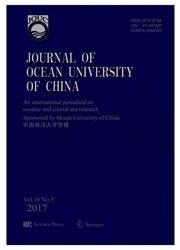

 中文摘要:
中文摘要:
The distributions of N utilizing bacteria (denitrifying bacteria and ammonifying bacteria) ,P utilizing bacteria (organic phosphobacteria and inorganic phosphobacteria) and heterotrophic bacteria in the Changjiang Estuary,and the roles of main environmental factors in distributing bacteria,are explored with observations from two cruises in June and August 2006.Comparisons between the two important periods of initial hypoxia phase (June) and developed hypoxia phase (August) show differences in both bacterial distributions and the associated main environmental factors.First,the primary group of ammonifying bacteria has larger magnitude with spatial maximum value in the hypoxic stations related to sediment in August.The phosphobacterial abundance and detection rates in August are much lower than those in June,but the denitrifying bacterial abundance becomes greater in August.However,the difference of heterotrophic bacterial abundance between June and August is not obvious.Second,main environmental factors influencing bacteria vary from initial hypoxia phase to developed hypoxia phase.Two parameters (salinity and NO3) in surface water and five environmental parameters (pH,salinity,PO43,NO3and temperature) in bottom water and surface sediment play major roles in the bacterial abundance in June,while different parameter combinations (salinity and PO43) in surface water and different parameter combinations (DO,DOC,NO3,PO43 and pH) in bottom water and surface sediment play major roles in August.Moreover,the bottom bacteria distributions in area south of 31 N are related to the position of the Taiwan Warm Current in June.The bacterial abundance and distribution may respond to the environmental change in the hypoxia processes of initial phase and developed phase.During the hypoxia processes,the whole structure of bacterial functional groups probably turns to different states,causing the recycling of nutrient regeneration and aggravating hypoxia regionally.
 英文摘要:
英文摘要:
The distributions of N utilizing bacteria (denitrifying bacteria and ammonifying bacteria), P utilizing bacteria (organic phosphobacteria and inorganic phosphobacteria) and heterotrophic bacteria in the Changjiang Estuary, and the roles of main environmental factors in distributing bacteria, are explored with observations from two cruises in June and August 2006. Comparisons between the two important periods of initial hypoxia phase (June) and developed hypoxia phase (August) show differences in both bacterial distributions and the associated main environmental factors. First, the primary group of ammonifying bacteria has larger magnitude with spatial maximum value in the hypoxic stations related to sediment in August. The phosphobacterial abundance and detection rates in August are much lower than those in June, but the denitrifying bacterial abundance becomes greater in August. However, the difference of heterotrophic bacterial abundance between June and August is not obvious. Second, main environmental factors influencing bacteria vary from initial hypoxia phase to developed hypoxia phase. Two parameters (salinity and NO_3^-) in surface water and five environmental parameters (pH, salinity, PO_4^3-, NO_3 and temperature) in bottom water and surface sediment play major roles in the bacterial abundance in June, while different parameter combinations (salinity and PO_4^3-) in surface water and different parameter combinations (DO, DOC, NO_3^-,PO_4^3- and pH) in bottom water and surface sediment play major roles in August. Moreover, the bottom bacteria distributions in area south of 31 °N are related to the position of the Taiwan Warm Current in June. The bacterial abundance and distribution may respond to the environmental change in the hypoxia processes of initial phase and developed phase. During the hypoxia processes, the whole structure of bacterial functional groups probably turns to different states, causing the recycling of nutrient regeneration and aggravating hypoxia regi
 同期刊论文项目
同期刊论文项目
 同项目期刊论文
同项目期刊论文
 期刊信息
期刊信息
